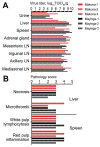Delayed Disease Progression in Cynomolgus Macaques Infected with Ebola Virus Makona Strain
- PMID: 26402165
- PMCID: PMC4593438
- DOI: 10.3201/eid2110.150259
Delayed Disease Progression in Cynomolgus Macaques Infected with Ebola Virus Makona Strain
Abstract
In late 2013, the largest documented outbreak of Ebola hemorrhagic fever started in Guinea and has since spread to neighboring countries, resulting in almost 27,000 cases and >11,000 deaths in humans. In March 2014, Ebola virus (EBOV) was identified as the causative agent. This study compares the pathogenesis of a new EBOV strain, Makona, which was isolated in Guinea in 2014 with the prototype strain from the 1976 EBOV outbreak in the former Zaire. Both strains cause lethal disease in cynomolgus macaques with similar pathologic changes and hallmark features of Ebola hemorrhagic fever. However, disease progression was delayed in EBOV-Makona-infected animals, suggesting decreased rather than increased virulence of this most recent EBOV strain.
Keywords: Ebola hemorrhagic fever; Ebola virus; Makona strain; Mayinga strain; West African Ebola virus isolate; cynomolgus macaques; nonhuman primates; pathogenesis; viruses.
Figures





References
-
- World Health Organization. Ebola situation report, May 13, 2015. Geneva: The Organization; 2015.
-
- Reed LJ, Muench H. A simple method of estimating fifty percent endpoints. Am J Hyg. 1938;27:493–7.
Publication types
MeSH terms
Grants and funding
LinkOut - more resources
Full Text Sources
Other Literature Sources
Medical

